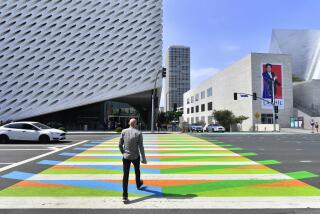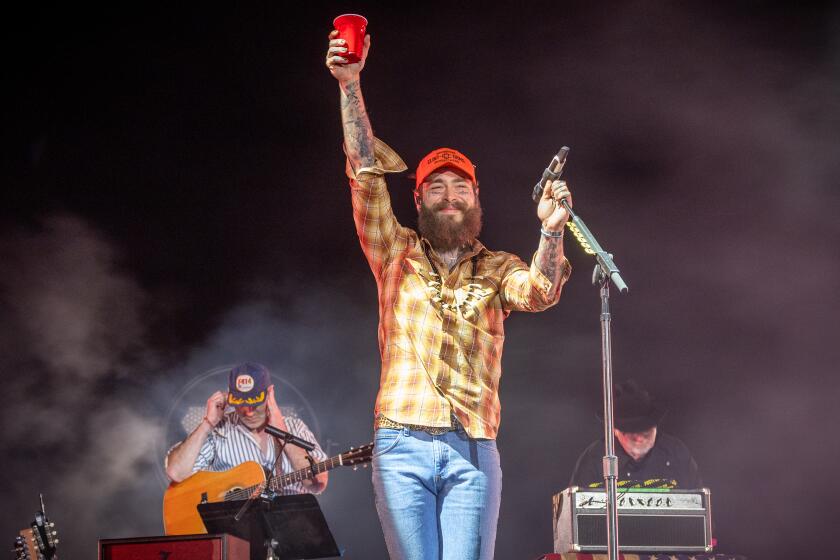Q&A: Jordan Wolfson’s robot-sculpture finds a home at the Broad museum
When downtown L.A.’s Broad museum finally opens this fall, it will have not only an inaugural exhibition featuring Eli and Edythe Broad’s contemporary art collection but also newly acquired works that will be rolled out later in the museum’s debut year, said Joanne Heyler, Broad Foundation director and chief curator.
One such piece is Jordan Wolfson’s life-sized, animatronic sculpture “(Female Figure) 2014.” The work generated much buzz when it premiered this year at David Zwirner gallery in Manhattan as part of the artist’s first solo show. The creepy-but-alluring blond wears a skimpy white dress, thigh-high vinyl boots and a dark green witch’s mask; her body is smeared with dirt. She dances in front of a mirror, speaks in Wolfson’s recorded voice and uses facial recognition technology to make eye contact with viewers.
Wolfson, 34, relocated to Los Angeles from New York about a year ago. During a recent visit to his Glendale studio for this Q&A and a sneak peek of “(Female Figure) 2014,” which the artist calls “optimistic,” the sculpture locked eyes and began rhythmically wriggling to Paul Simon’s “Graceland.” Then she started talking.
She talks a lot: “I’m getting old, I’m getting fat, I don’t believe in God.” How does the text connect to the work and where does it come from?
I just write it for myself -- it’s intuitive, not conceptual. Think of me as a songwriter or author, someone writing a script for a play. It’s fiction. It opens with: “My mother is dead, my father is dead, I’m gay, I’d like to be a poet, this is my house.” My parents aren’t dead and I’m not homosexual. But it’s not about me. It’s fiction, it’s literature, it’s writing.
As a sculptor and video artist, did you encounter a steep technological learning curve to bring this piece to life?
I worked with animatronic specialists to make the artwork, so I was more in a position of directing than actual sculpting myself. It was a very intensive process. There’s a physical gap between you and the artwork, but I was there the whole time. I didn’t cast the rubber, but I made every single aesthetic decision. I was so glad it was possible to reach the physicality we were able to reach with the work, because I didn’t know how far it was possible to push it. I didn’t totally understand because I wasn’t familiar with the process. Once we saw one thing move, I wanted more and more and more. It was a very interesting experience working in the physical space this way, rather than the video space.
What’s the purpose of the mask, and why is she covered in dirt?
The mask is a formal device to invert the sense of titillation; I wasn’t interested in the character being sexually titillating. It was almost a combination of fertility and infertility, with the mask representing an infertile state. The dirt was about the idea that she had escaped from something, but she’s not hurt. There are no red marks. She’s unscathed, but dirty. It’s an incredibly positive artwork in that it’s about escaping from conformity.
Your choices are so specific -- the mirror, the eye contact, her outfit -- what are you trying to convey with the work? I’m not trying to convey, or say, anything through my work. I’d been thinking a lot about the viewer, and also thinking about sculpture, formally. I don’t care about people’s reactions to it. It’s an artwork, I do what’s interesting to me. I was mostly just interested in the physicality of what I’d seen in the animatronic field, and I was also interested in making a sculpture that had the potential to be chronological or structural in the same way a video is. My hope is that the work dips in and out of spectacle.
The work has been described as a look into the future. Is this what you were going for? And if so, what’s it saying about the future?
I don’t disagree or agree with that. I wasn’t thinking at all about the future or the past while making this artwork. The look of it -- that was economically how the robot had to look, with the materials available. It was about utility, it wasn’t meant to be futuristic. It’s part of reality, this thing exists, it just looks as it looks. Aesthetically, I was just going for a combination of textures, matte and shiny, and also physicality, so there’s always a contrast.
Who are some of your influences?
I’ve been influenced by Charles Ray, by Jeff Koons and Bruce Nauman, Matthew Barney. Cindy Sherman is someone who’s really important to me. Sturtevant, all these artists. But with this piece, I was most influenced by seeing the physicality of the animatronic.
What are you working on now?
I’m working on a solo show for the Serpentine Galleries in London. That’s next fall. It’ll be a new video and new sculptures. It’s building on the same technology we used for this piece, but it won’t be this -- or even [similar], either. It’s it own work. It’s completely different.
You moved to L.A. last September. Does being part of the Broad museum so soon after its debut make you feel more connected to the city?
It feels good. I’m honored that my work will be on display in the city it was created in. It feels like I’m really an L.A. artist now.
Twitter: @debvankin
More to Read
The biggest entertainment stories
Get our big stories about Hollywood, film, television, music, arts, culture and more right in your inbox as soon as they publish.
You may occasionally receive promotional content from the Los Angeles Times.







